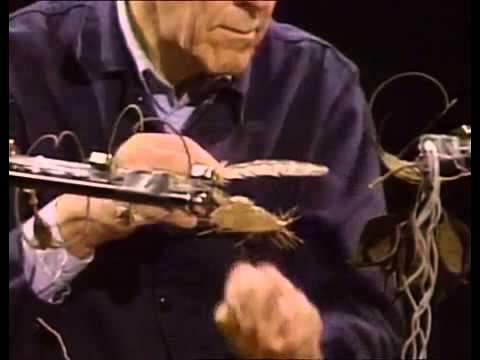Is John Cage's 4'33'' music?: Prof. Julian Dodd at TEDxUniversityOfManchester
Summary
TLDRThe script discusses John Cage's avant-garde piece '4 minutes 33 seconds,' where performers remain silent, highlighting ambient sounds. It challenges traditional music norms, emphasizing Cage's intent to appreciate environmental sounds aesthetically. The lecturer argues that while it's an important artwork, it doesn't meet the criteria to be considered music due to its lack of composer-guided sound production.
Takeaways
- 🎶 John Cage's '4 minutes 33 seconds' is a performance where the musicians do not play their instruments, but it is not a silent piece.
- 🤔 The sounds heard during the performance, like ambient noise or audience sounds, become part of the performance itself.
- 🎵 Cage believes that the acceptance of ambient sounds in a performance makes the piece modern.
- 🖼️ The speaker argues that while '4 minutes 33 seconds' is a significant and profound piece of art, it is not music.
- 🛠️ Cage's piece is seen as a challenge to traditional views of music, aiming to make us appreciate the aesthetic qualities of everyday sounds.
- 💭 Cage opposed what the speaker calls 'composer fetishism,' trying to remove his own ego from the work by not controlling how the performance sounds.
- 🎼 A defining feature of music is the organization of sounds by a composer, usually through performers following specific instructions.
- 📻 Cage's other avant-garde work, 'Imaginary Landscape No. 4,' still qualifies as music because it involves performers following detailed instructions, even if the sound isn't predetermined.
- 🎨 The speaker believes that '4 minutes 33 seconds' is a piece of conceptual art, not music, as it lacks the organized sound element typically required for music.
- 🧐 The piece prompts the audience to question the nature of music and art, encouraging deeper listening and reflection on the sounds of the environment.
Q & A
What is John Cage's piece '4 minutes 33 seconds' about?
-'4 minutes 33 seconds' is a composition by John Cage where the performers do not play their instruments. Instead, the ambient sounds in the environment during the performance become part of the piece, challenging the traditional concept of music.
Why is '4 minutes 33 seconds' not considered a silent piece?
-The piece is not silent because it includes all the ambient sounds during the performance, such as people shuffling, coughing, or sounds from the environment, which are incorporated as part of the composition.
What does Cage aim to challenge with '4 minutes 33 seconds'?
-Cage challenges the traditional valorization of classical works and the rigid expectations of music performance. He encourages listeners to appreciate the aesthetic qualities of everyday environmental sounds, which are often overlooked in traditional settings.
How does Cage try to remove his ego from '4 minutes 33 seconds'?
-Cage removes his ego by allowing the sounds of the performance to be generated by the audience and environment, rather than controlling them through his own preferences or detailed musical instructions.
Why does the speaker believe '4 minutes 33 seconds' is not music?
-The speaker argues that '4 minutes 33 seconds' does not meet the condition for being a work of music because the sounds that make up the performance are not produced by the performers following the composer’s specific instructions.
What is the key difference between traditional music and '4 minutes 33 seconds'?
-In traditional music, performers follow a score to produce sounds according to the composer’s instructions. In '4 minutes 33 seconds', the performers do not produce sounds, and the ambient noise becomes the central focus, which is why it doesn’t fit the standard definition of music.
How does Cage's 'Imaginary Landscape No. 4' compare to '4 minutes 33 seconds'?
-'Imaginary Landscape No. 4' involves performers following specific instructions to manipulate radios, making it a work of music by the speaker's definition. However, '4 minutes 33 seconds' doesn’t involve performers producing sound based on the composer’s instructions, so it is not classified as music.
What is the 'art political' message of '4 minutes 33 seconds'?
-The 'art political' message is that traditional music limits our appreciation of the sounds around us. Cage’s piece encourages us to listen to environmental sounds with the same attention we give to music, challenging the boundary between music and noise.
Why does the speaker argue that it doesn’t matter if '4 minutes 33 seconds' is not music?
-The speaker believes it doesn’t matter because the piece still fulfills its purpose by questioning the nature of music and encouraging an appreciation for environmental sounds, even if it is not technically considered music.
How does Cage’s Zen Buddhism influence '4 minutes 33 seconds'?
-Cage’s Zen Buddhism may have influenced his desire to remove his ego from the composition and allow the performance to unfold naturally, without his direct control over how it sounds.
Outlines

このセクションは有料ユーザー限定です。 アクセスするには、アップグレードをお願いします。
今すぐアップグレードMindmap

このセクションは有料ユーザー限定です。 アクセスするには、アップグレードをお願いします。
今すぐアップグレードKeywords

このセクションは有料ユーザー限定です。 アクセスするには、アップグレードをお願いします。
今すぐアップグレードHighlights

このセクションは有料ユーザー限定です。 アクセスするには、アップグレードをお願いします。
今すぐアップグレードTranscripts

このセクションは有料ユーザー限定です。 アクセスするには、アップグレードをお願いします。
今すぐアップグレード関連動画をさらに表示

Meklit Hadero: The unexpected beauty of everyday sounds | TED

John Cage playing amplified cacti and plant materials with a feather YouTube

Great Composers: John Cage

PAS 3 - Quarteto de Cordas com Helicópteros | FOCO NAS OBRAS

Keselamatan dan kesehatan kerja (K3) [Perhotelan]

Bambi Read Along Storybook in HD
5.0 / 5 (0 votes)
